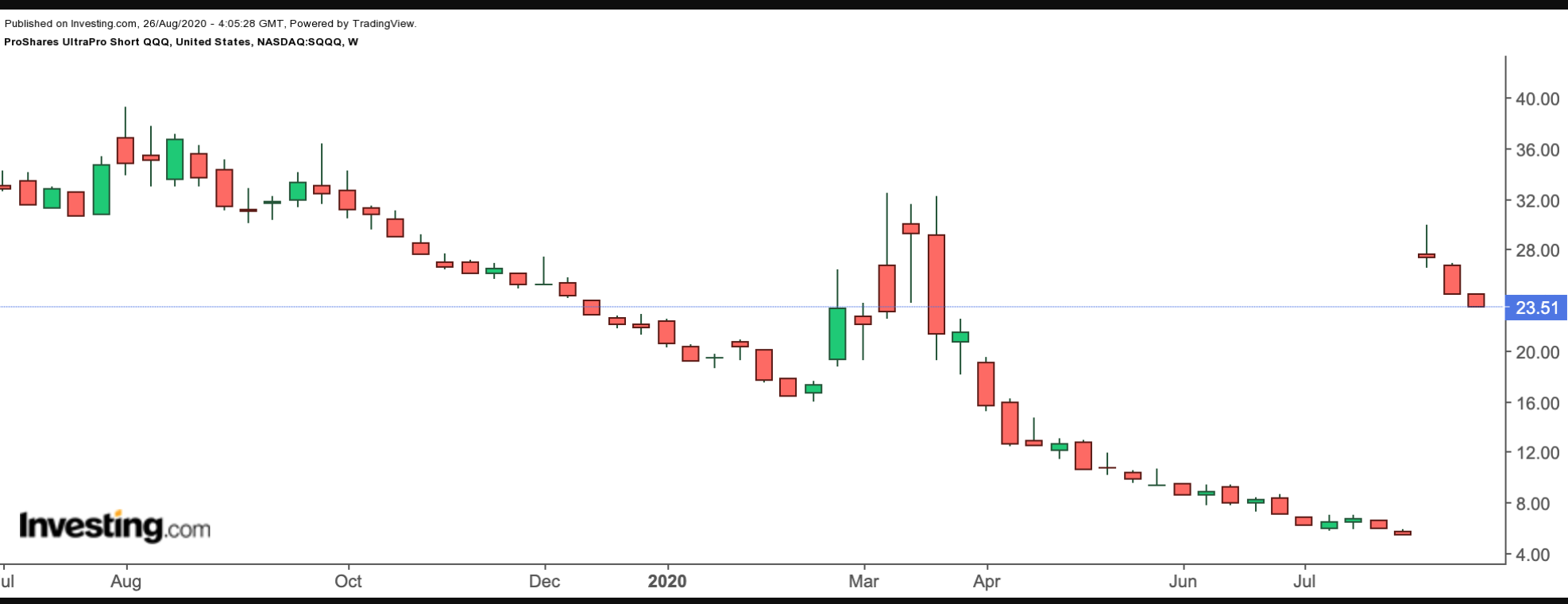While broader equity markets continue their run higher, many may be wondering how they can grab downside profits when the next leg lower or even a bear market arrives.
The ever-expanding universe of inverse (or short) exchange-traded funds (ETFs) is one such avenue since their value increases if the corresponding benchmark index falls.
This objective is typically achieved through the use of more complex derivative products. However, not every retail investor has a brokerage account that allows them to short-sell ETFs or stocks.
Inverse ETFs can create the desired hedging effect in a portfolio or allow investors to take advantage of a short-term directional bet. This ease of trading is one potential benefit, especially with the surge in online trading platforms like Robinhood amid coronavirus. Before buying, it is crucial to appreciate the risk/return profile of a given inverse ETF first. Here's why:
Risks And Rewards
Inverse ETFs offer short-term traders and even hedge funds a structured product to take directional bets on a range of equity indices, sectors and assets.
These inverse ETFs provide short exposure to the daily return of various indices, sectors or asset classes. The fund space also comprises leveraged inverse ETFs offering −2× or −3× the underlying index returns, which means risks and returns will be turbocharged. As we have previously discussed, leveraged ETFs use swaps, options, futures contracts and other financial instruments to create the daily desired gearing.
Geared daily returns cannot be created out of thin air. Leveraged ETFs must rebalance their exposures each day to produce the returns indicated in the fund's prospectus. Holders of short ETFs need to pay close attention to the markets as well as their positions with the understanding that these inverse ETFs are not appropriate as a long-term investing strategy. Any investor who holds leveraged ETFs for a long period will find out that his or her capital could eventually be eaten up by the daily re-balancing.
Finally, fees on these funds tend to be higher than the expense ratios of regular ETFs. Daily rebalancing requires frequent trading, which increases a given fund's expenses. Furthermore, depending on the type of brokerage account used by retail investors, there would likely be margin requirements and costs associated with holding these positions intraday or overnight.
Below we'll take a closer look at an inverse leveraged ETF:
ProShares UltraPro Short QQQ
- Current Price: $23.51
- 52-Week Range: $23.46 - 181.60
- Dividend Distributions: Quarterly
- Dividend Yield: 0.82
- Expense Ratio: 0.95 % per year, or $95 on a $10,000 investment
ProShares UltraPro Short QQQ (NASDAQ:SQQQ) seeks daily investment results, before fees and expenses, that correspond to three times the inverse (-3x) of the daily performance of the NASDAQ 100 index.

SQQQ includes 103 holdings, and the top ten comprise over 50% of the fund. The top three companies are Apple (NASDAQ:AAPL), Microsoft (NASDAQ:MSFT) and Amazon (NASDAQ:AMZN).
The sector allocation (by weighting) is Information Technology (48.36%), Communication Services (19.72%), Consumer Discretionary (17.11%), Healthcare (7.25%), Consumer Staples (4.89%), Industrials (2.01%) and Utilities (0.66%).
Leveraged and inverse ETFs are not suitable for buy-and-hold investors since the long-run returns can be significantly below that of the underlying index. SQQQ’s prospectus clearly states that "due to the compounding of daily returns, holding periods of greater than one day can result in returns that are significantly different than the target return."
Year-to-date, SQQQ is down 78%. By comparison, the NASDAQ 100 index is up 32%. This clearly shows that SQQQ’s objective is daily, but not long-term, returns.
As of Aug.18, the ETF had a 1:5 reverse split when it started trading at its post-split price. A reverse split meant an investor holding 100 shares of a $5-a-share ETF will own 20 shares worth $25 each after a 1:5 reverse split. The total amount of the investment remains unchanged.
Such reverse splits are quite common with leveraged funds whose prices have been falling. Fund managers typically initiate a reverse split to make it more attractive in the eyes of investors or to avoid getting delisted from an exchange due to low prices.
Bottom Line
Inverse ETFs, including leveraged inverse funds, typically offer a great deal of return and risk potential when compared to traditional products. However, given the risks involved, they are generally recommended only as short-term and relatively small holdings in a more substantial portfolio.
Those investors who want to hedge some portfolio risk or have a bearish opinion on a certain market index or asset class may consider several other inverse exchange-traded funds, including:
- Direxion Daily Jr. Gold Miners Bear 2X ETF (NYSE:JDST)
- MicroSectors US Big Banks Index 2X Inverse Leveraged (NYSE:BNKZ)
- ProShares UltraPro Short MSCI Emerging Markets (EEV:NYSE Arca)
- ProShares UltraPro Short S&P500 (NYSE:SPXU)
Retail investors interested in inverse ETFs should consider talking to a registered financial advisor.
